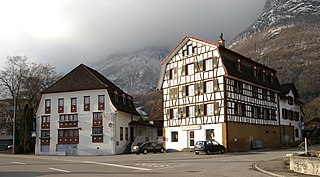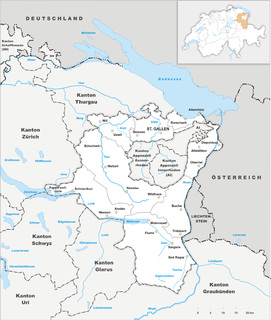The 26 cantons of Switzerland are the member states of the Swiss Confederation. The nucleus of the Swiss Confederacy in the form of the first three confederate allies used to be referred to as the Waldstätte. Two further major steps in the development of the Swiss cantonal system are referred to by the terms Acht Orte and Dreizehn Orte ; they were important intermediate periods of the Ancient Swiss Confederacy.

The Alpine Rhine Valley is a glacial alpine valley, formed by the part of the Alpine Rhine between the confluence of the Anterior Rhine and Posterior Rhine at Reichenau and the Alpine Rhine's mouth at Lake Constance. It covers three countries and the full length of the Apine Rhine is 93.5 km.

The canton of Thurgau is a northeast canton of Switzerland.
Appenzell is a historic canton in the northeast of Switzerland, and entirely surrounded by the canton of St. Gallen.
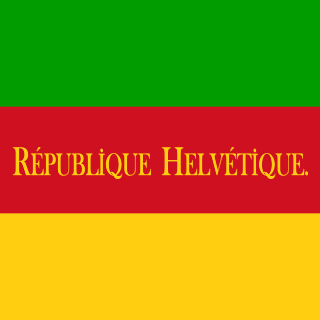
In Swiss history, the Helvetic Republic (1798–1803) represented an early attempt to impose a central authority over Switzerland, which until then had consisted of self-governing cantons united by a loose military alliance.

Each of the 26 modern cantons of Switzerland has an official flag and a coat of arms. The history of development of these designs spans the 13th to the 20th centuries.
During the French Revolutionary Wars, the revolutionary armies marched eastward, enveloping Switzerland in their battles against Austria. In 1798, Switzerland was completely overrun by the French and was renamed the Helvetic Republic. The Helvetic Republic encountered severe economic and political problems. In 1798 the country became a battlefield of the Revolutionary Wars, culminating in the Battles of Zürich in 1799.

Rheinau Abbey was a Benedictine monastery in Rheinau in the Canton of Zürich, Switzerland, founded in about 778 and suppressed in 1862. It is located on an island in the Rhine.

The Old Swiss Confederacy was a loose confederation of independent small states within the Holy Roman Empire. It is the precursor of the modern state of Switzerland.

The County of Sargans was a state of the Holy Roman Empire. From 1458 until the French Revolutionary War in 1798, Sargans became a condominium of the Old Swiss Confederacy, administered jointly by the cantons of Uri, Schwyz, Unterwalden, Lucerne, Zürich, Glarus and Zug.

Schänis Abbey was founded in the 9th century. It was situated in the present town of Schänis in the canton of St. Gallen, Switzerland. It was a house of secular canonesses of the nobility and was dissolved in 1811.

Vogtei Rheintal was a condominium of the Old Swiss Confederacy from the 15th century until 1798. Its territory corresponded to the left banks of the Alpine Rhine between Hoher Kasten and Lake Constance, including the towns of Altstätten and Rheineck.

Hohensax is a ruined castle in the Sennwald municipality in the Swiss canton St. Gallen. The castle was built around 1200 by the barons of Sax, and was destroyed in 1446. In 1248, the castle passed to Ulrich von Sax, founder of the Sax-Hohensax line of the noble family. The castle was plundered in a feud of 1393, and sold together with the villages of Sax and Gams to the dukes of Austria. In the Old Zürich War, the people of Appenzell captured and slighted the castle in 1446. After this, the barons of Hohensax resided in the nearby Forstegg castle at Salez. In 1640, the ruin passed to the barony of Sax-Forstegg, one of the constituent parts of the canton of Linth of the Helvetic Republic in 1798, and later the canton of St. Gallen. It included the villages of Sax, Salez and Gams.
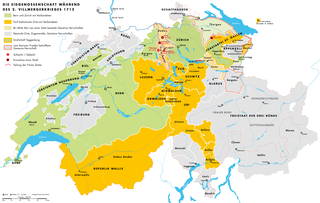
The Toggenburg War, also known as the Second War of Villmergen or the Swiss Civil War of 1712, was a Swiss civil war during the Old Swiss Confederacy, that took place from 12 April until 11 August 1712. On the one hand there were the Catholic "inner cantons" and the Imperial Abbey of Saint Gall, on the other the Protestant cantons of Bern and Zürich as well as the abbatial subjects of Toggenburg. The conflict was simultaneously a religious war, a war for the hegemony within the Confederacy and an uprising of subjects. The war ended in a Protestant victory and toppled the balance of political power within the Confederacy.
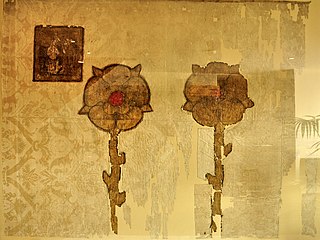
The Juliusbanner are elaborate silk banners given to the cantons and other entities of the Old Swiss Confederacy by Pope Julius II in 1512, in recognition of the support he received from Swiss mercenaries against France in the Pavia campaign.

Forstegg Castle is a ruined castle in the municipality of Sennwald of the Canton of St Gallen in Switzerland. It was built around 1200 by the Barons of Sax/Misox, was abandoned in the 19th century and fell into ruin in 1894.

The Thurgau was a pagus of the Duchy of Alamannia in the early medieval period. A County of Thurgau existed from the 13th century until 1798. Parts of Thurgau were acquired by the Old Swiss Confederacy during the early 15th century, and the entire county passed to the Confederacy as a condominium in 1460.
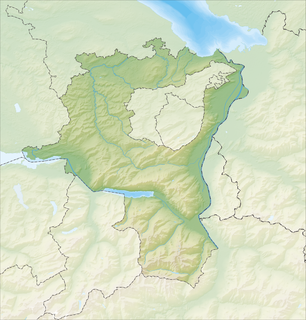
Frischenberg is a ruined castle in Sennwald, canton of St. Gallen, Switzerland. It was built in the early 14th century by the lords of Hohensax, probably by Ulrich III von Hohensax some time after 1313. It was destroyed and rebuilt in 1446, and abandoned in 1551.

